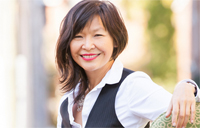Recently, York’s Canadian Writers in Person course and lecture series presented author Carrianne Leung reading from her debut novel The Wondrous Woo. Special correspondent Chris Cornish (BA Hons. ’04, MA ’09) sent the following report to YFile.
One afternoon by the third movie, I got annoyed. “These women are getting shafted,” I had said, pointing to the eye-batting peasant girl washing clothes in the brook. “If she hadn’t rescued her man from drowning, the show’d be over.”
Ba had leaned over and paused the video, something we never did (we never needed to; peeing could always wait). He had scratched at his chin and looked me in the eye. “One day, Miramar,” he said, “you should write these stories from the side of the women. Make the world know how powerful they are. Like you.”
from The Wondrous Woo
by Carrianne K. Y. Leung

Carrianne Leung believes that “home is not always a place of comfort but of eruptions, and sometimes violent eruptions.” Such an eruption happens early in her debut novel The Wondrous Woo, and the protagonist Miramar Woo needs to leave her home in suburban Scarborough to truly understand what it means to her. The author, who was shortlisted for the Toronto Book award, recently shared her thoughts about her novel with the Canadian Writers in Person series.
In the novel, Miramar goes on a hero’s journey, but one where the place is mundane rather than magical, the time period campy rather than epic, and the eventual return home not so much triumphant as restorative. Leung playfully employs elements of magic realism to highlight the schisms between internal and external realities. She binds Miramar’s everyday experience to a magical mishmash of fables and pop culture references (Pat Benatar, Madonna and Prince’s Purple Rain), elevating the ordinary to the epic. Her siblings magically develop “gifts” in math and music that are ironically stereotypical, while Miramar has imaginary Kung Fu battles in her apartment despite her outwardly meek appearance. The magic of these scenes makes the painful reality that much more real but also gives her a framework to work out her problems.
 This is a story where space, time, and identity are inextricably linked. Partly based on Leung’s own experience in one of the first Chinese-Canadian families in Scarborough in the 1970s and 1980s, the novel explores “the hopefulness and despair of growing up as a racialized person in a suburban space at this time.” One of the only visible representations in Western culture then was the Calgon detergent commercial proclaiming the cleaning power of “ancient Chinese secrets” and before the demographics changed, the suburb was predominantly white. Links to Chinese culture were found in trips to the Golden Harvest Theatre at Dundas and Spadina and later renting VHS tapes of Hong Kong movies. Leung suggests that Miramar’s identity is cobbled together from these films and fables, the western popular culture, and her lived experience.
This is a story where space, time, and identity are inextricably linked. Partly based on Leung’s own experience in one of the first Chinese-Canadian families in Scarborough in the 1970s and 1980s, the novel explores “the hopefulness and despair of growing up as a racialized person in a suburban space at this time.” One of the only visible representations in Western culture then was the Calgon detergent commercial proclaiming the cleaning power of “ancient Chinese secrets” and before the demographics changed, the suburb was predominantly white. Links to Chinese culture were found in trips to the Golden Harvest Theatre at Dundas and Spadina and later renting VHS tapes of Hong Kong movies. Leung suggests that Miramar’s identity is cobbled together from these films and fables, the western popular culture, and her lived experience.
Leung rejects the notion that there are two different worlds for her characters, one Chinese and one Canadian. Rather, “we exist in one body with seamless and jarring experiences, that both resonate sometimes, and deeply disrupt at other times, and that’s just called life. I start from the assumption that we all live in these spaces in hybridity,” she said. Likewise, Leung doesn’t feel the assumed pressure of being representative of Chinese-Canadian people. Though she is of that culture, she echoes the concern of Chimamanda Adichie who warns of the danger of the single story in her famous TED talk. Rather, there are a multitude of individual stories in a vast diaspora, and none of them should be taken as representative of the whole.
Leung also poses interesting questions about madness through Miramar’s mother and “Mouse”, characters haunted by history both personal and communal. Particularly in immigrant communities, “are people mad for responding to profound displacement, when they’re coming from pasts that were war torn, genocidal, impoverished? Are people of colour or indigenous folks crazy when they push back against conditions that leave them little space to breathe, to live, to sustain and imagine themselves? When is madness the response to the erasure of history and identity?” she asked.
Leung’s story is not quite autobiographical: although her protagonist grew up in the same time/place, went to the same university, and had the same job, the author claims Miramar is way cooler than she ever was and the story and other characters have major differences. Yet, one can’t help but wonder if Leung embodies one of the gifts bestowed on Miramar by her father, to show the power of one woman’s story.
The Canadian Writers in Person series of public readings at York University, which are free and open to the public, are also part of an introductory course on Canadian literature. It is sponsored in part by the Canada Council for the Arts. For a full schedule of upcoming writers this year, see the Sept. 15 issue of YFile.


